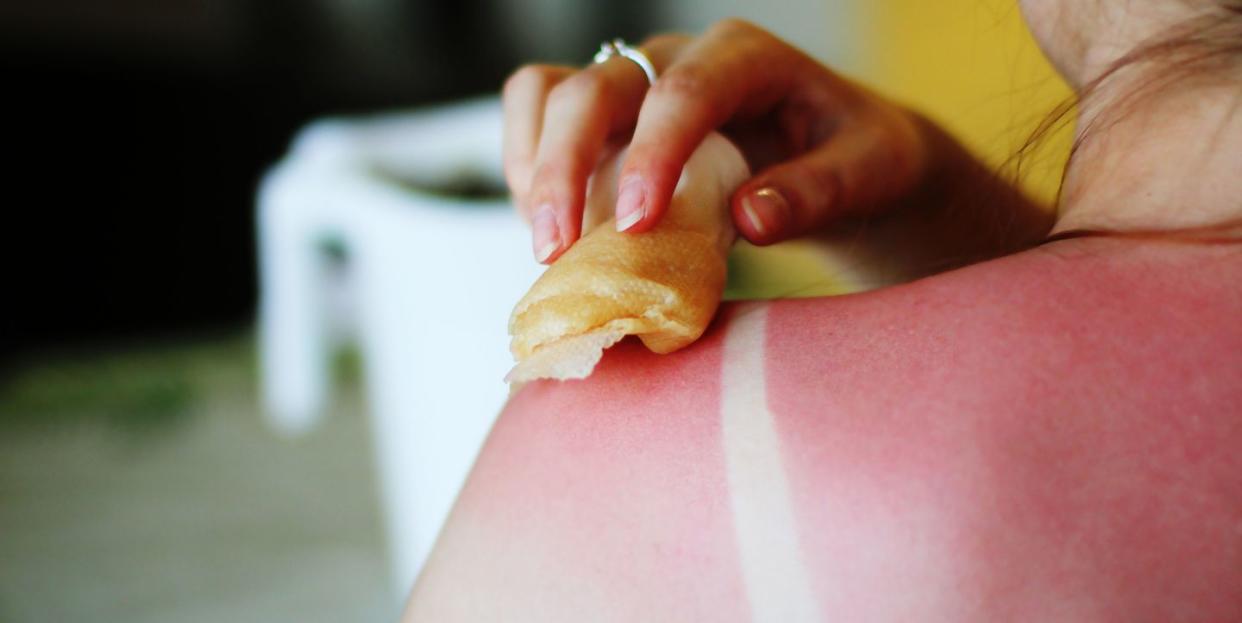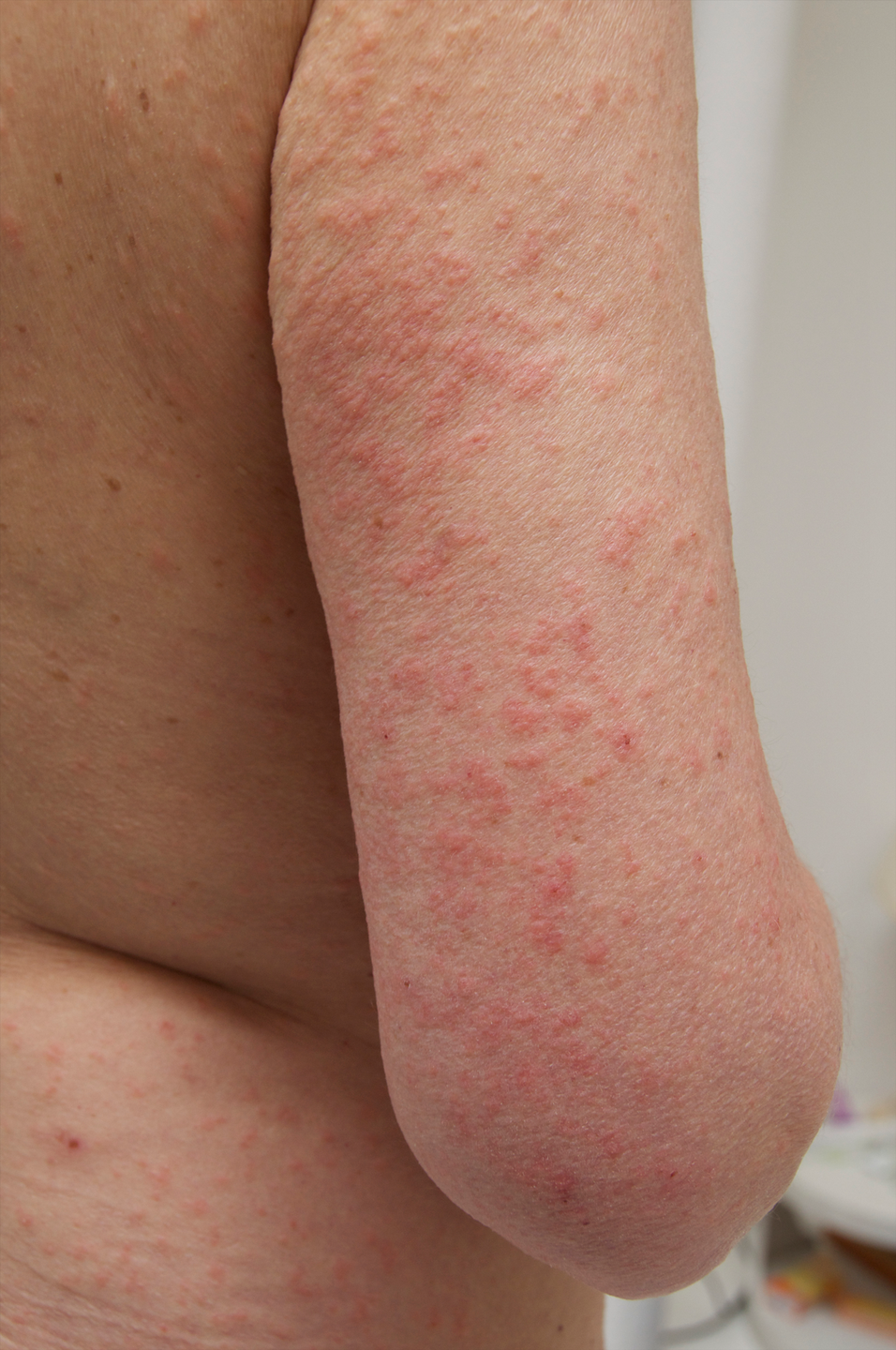How to Tell if Your Nasty Sunburn Has Turned Into Sun Poisoning, According to Doctors

You’re red, you’re peeling, and you’re kicking yourself for not reapplying sunscreen every two hours like you’re supposed to. Other than waiting it out and slathering on some aloe vera, there’s not much you can do to treat a sunburn.
But if your sunburn symptoms are paired with side effects that are more severe, like blisters and a fever, you might have a case of sun poisoning, a condition where a really bad sunburn makes you feel ill.
Still, how exactly do you spot the difference between a sunburn and full-on sun poisoning? Here, we asked dermatologists to explain what sun poisoning is, how to recognize the telltale symptoms (including a rash), and what you can do to feel better ASAP.
What is sun poisoning, exactly?
Sun poisoning is the term used to describe a really bad sunburn caused by prolonged UV exposure. But it’s probably not something you’ll be diagnosed with if you go to a doctor’s office.
“It’s kind of a layman’s term,” says John Zampella, M.D., a dermatologist at NYU Langone. “If you open up the dermatology textbook, there’s no chapter on sun poisoning. When someone either gets too much sun or has a very strong reaction to the sun, triggering a flu-like response, we call it sun poisoning.”
You might not be able tell if you have sun poisoning right away, since its symptoms can appear up to 72 hours after a bad sunburn. To really understand how sun poisoning is different from a sunburn, Dr. Zampella says you need to be familiar with the symptoms of both. You can’t have sun poisoning without a sunburn.
Sunburn vs. sun poisoning symptoms
Normal sunburn
Red, inflamed, and tender skin 30 minutes to 24 hours after sun exposure
Severe sunburn
Blistering 24 to 48 hours after sun exposure
Sun poisoning
All of the above sunburn symptoms, plus symptoms known as systemic reactions, including:
Chills
Nausea
Joint pain
Muscle aches
Malaise
Dizziness/lightheadedness
What does a sun poisoning rash look like?
Some people are more prone to sun poisoning than others. “People with fair skin and light eyes who get sunburned more easily are more likely to suffer from sun poisoning,” says Brian Brosnan, M.D., chief of Dermatology at Kaiser Permanente Panorama City Medical Center in Southern California. “People who have a family history of skin cancer are also more likely to get sun poisoning. People who are taking medications, including antibiotics and oral contraceptives, are more susceptible because some medications heighten sensitivity to the sun.”
When it’s not caused by something like medication, that heightened sun sensitivity, called photosensitivity, encompasses a couple of conditions that are often confused with sun poisoning. While these conditions, which result in an inflamed rash, increase your chances of getting sun poisoning if you spend too much time in the sun, they are not different types of sun poisoning:
Polymorphous light eruption (PMLE)

This is an itchy, bumpy rash caused by sun exposure in people with sunlight sensitivity, and is more common in women and those with a family history of PMLE, according to Dr. Brosnan. “PMLE typically occurs and is worse at the beginning of the summer season, he says. “The rash typically lessens over two to three weeks time.”
Solar urticaria (SU)
This is a sun allergy resulting in hives that usually appear within minutes of sun exposure. Dr. Zampella explains it’s much more rare than PMLE.
“There’s often this idea that polymorphous light eruption and solar urticaria are the same things as sun poisoning, and that’s not true,” Dr. Zampella says. “You want to think about sun poisoning as the symptom. You can get there simply through too much sun, or you can get there from one of these allergic sun reactions. The end result is the burn. But if you have something like PMLE, that makes you more sensitive to the sun, and you could more easily get sun poisoning even if you weren’t out there as long.”
Sun poisoning treatment
Most sun poisoning symptoms can be treated with at-home remedies:
Soak in cool water or use cold compresses to make yourself more comfortable.
Apply aloe vera or any thick moisturizer to soothe the skin and conserve moisture.
Drink plenty of water to maintain hydration.
Take an anti-inflammatory, like ibuprofen, to help with tenderness and discomfort. While it’s not an anti-inflammatory, Dr. Zampella says Tylenol can help too.
If your sun poisoning symptoms escalate into very severe reactions, like a drop in blood pressure, heart palpitations, or dizziness and fainting, or if dehydration and blistering become extreme, both Dr. Zampella and Dr. Brosnan say you should head to the doctor. A physician may recommend a few different types of treatment:
Prescription medication to prevent blistered skin from becoming infected
IV fluids to hydrate you and normalize your electrolyte levels
How to prevent sun poisoning
Of course, limiting your sun exposure, especially if you have any sun sensitivities, can prevent sun poisoning. The Food and Drug Administration (FDA) specifically recommends limiting your time in the sun between 10 a.m. and 2 p.m., when the sun’s rays are strongest.
Above all, however, Dr. Zampella emphasizes the need to apply the right kind of sunscreen with the right frequency. “With any sun sensitivity, the best thing you can do is wear your sunscreen,” he says. “Make sure it’s broad spectrum, meaning it protects against both UVA and UVB rays. Photosensitivity is caused by UVA, and a sunscreen’s SPF is only a measure of UVB. You need to reapply sunscreen every two hours.”
With so many sunscreens on the market, you might not know where to start. See the top dermatologist-recommended sunscreens here.
Support from readers like you helps us do our best work. Go here to subscribe to Prevention and get 12 FREE gifts. And sign up for our FREE newsletter here for daily health, nutrition, and fitness advice.
You Might Also Like
